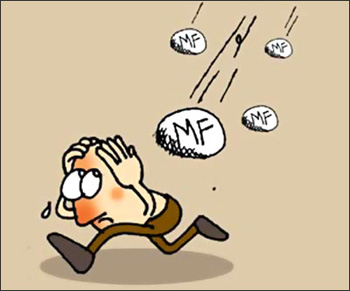Photographs: Reuters Masoom Gupte in Mumbai
Mutual funds entails several costs, payable at different stages.
These include:
On investing: Entry load or the upfront fee levied by mutual funds while investing was abolished by Securities and Exchange Board of India from August 1, 2009.
In lieu of that, an advisory fee of 1-2 per cent of the investment amount is charged by distributors.
This fee depends on the agreement between the investor and the distributor.
However, if you invest via a broker (stock exchange platform), instead of the advisory fee, a transaction fee (about 0.5 per cent) is charged, which is similar to brokerage paid while trading in equities.
If you approach the fund house directly, no charges are levied.
. . .
How to calculate mutual funds' costs
Recurring cost: Each mutual fund scheme discloses an 'expense ratio'.
This signifies the proportion of recurring expenses that a fund charges to its schemes' assets under management year after year.
This includes fund management fee, administrative costs and marketing and advertising costs incurred by the fund house.
The expense ratio varies across fund houses and schemes.
However, Sebi has capped the annual charges at 2.5 per cent of the AUM for equity funds and 2.25 per cent for debt funds for the initial corpus of Rs 300 collected.
The cap dips as the AUM increases.
. . .
How to calculate mutual funds' costs
Reason: as the expense ratio is charged as a percentage of the total AUM, it spreads across a larger corpus.
Thus, it reduces by 0.25 per cent with each consecutive tranche of Rs 300 crore (Rs 3 billion) collected for equity as well as debt schemes.
It is finally capped at 1.75 per cent for equity schemes and 1.5 per cent for debt funds, each with a corpus exceeding Rs 900 crore (Rs 9 billion).
So, those who enter a fund with a smaller corpus, effectively pay a higher fee. Whereas, those entering with a larger corpus pay lower charges.
. . .
How to calculate mutual funds' costs
For index funds and exchange-traded funds, the expense ratio is capped at 1.5 per cent of the AUM, irrespective of the corpus accumulated.
You do not have to pay these charges separately.
The net asset value of the units held by you is declared after deducting these charges.
On redemption: Conventionally, an exit load of about a per cent of the total redemption amount is levied for premature withdrawals, usually made within a year of the investment.
Each company can stipulate this lock-in period independently.
. . .
How to calculate mutual funds' costs
However, there is restriction on the exit load charged. Except, if it exceeds one per cent, the excess must be reinvested in the scheme.
Investors also have to pay a Securities and Transaction Tax of 0.25 per cent on redemption.
It is applicable irrespective of the investment channel chosen.
But the manner of levying the tax varies with your choice of intermediary. If invested via a non-exchange channel,
STT will be levied on redemption.
But over the exchange platform, STT is divided into two parts of 0.125 per cent each and levied both on investing and redeeming.







article